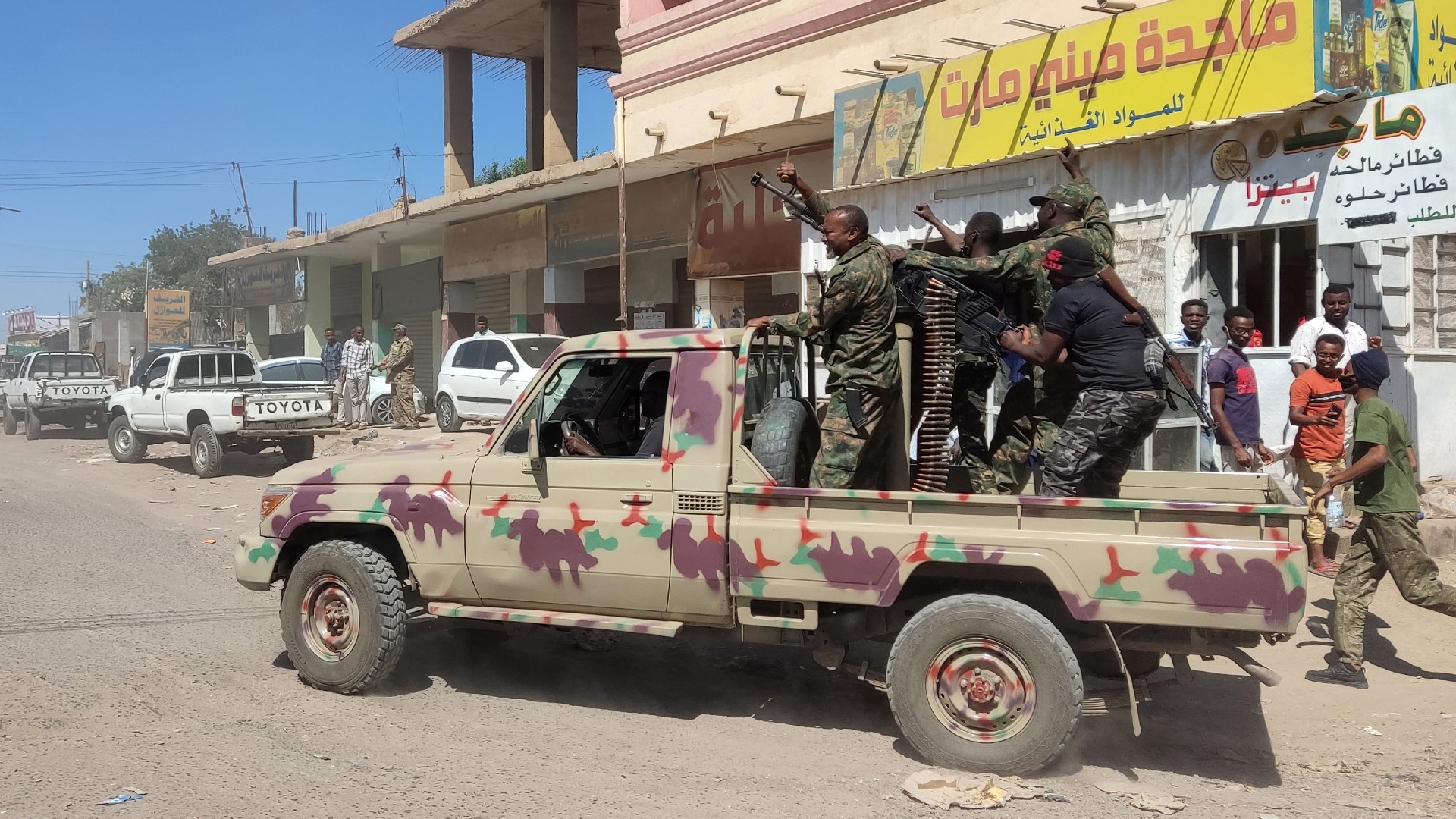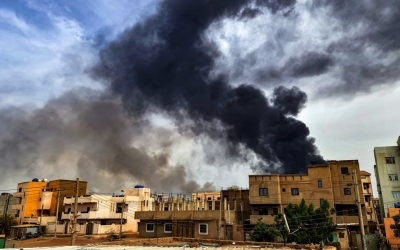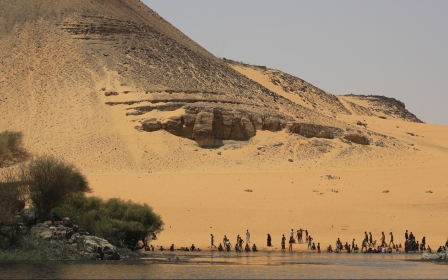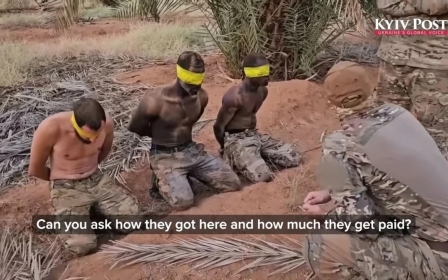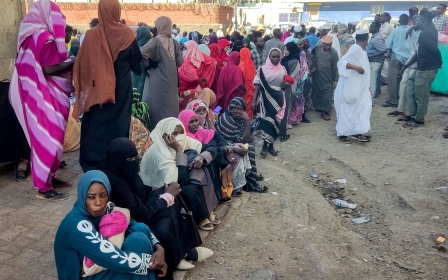Sudan war: Gory beheading video emerges as army advances in the capital
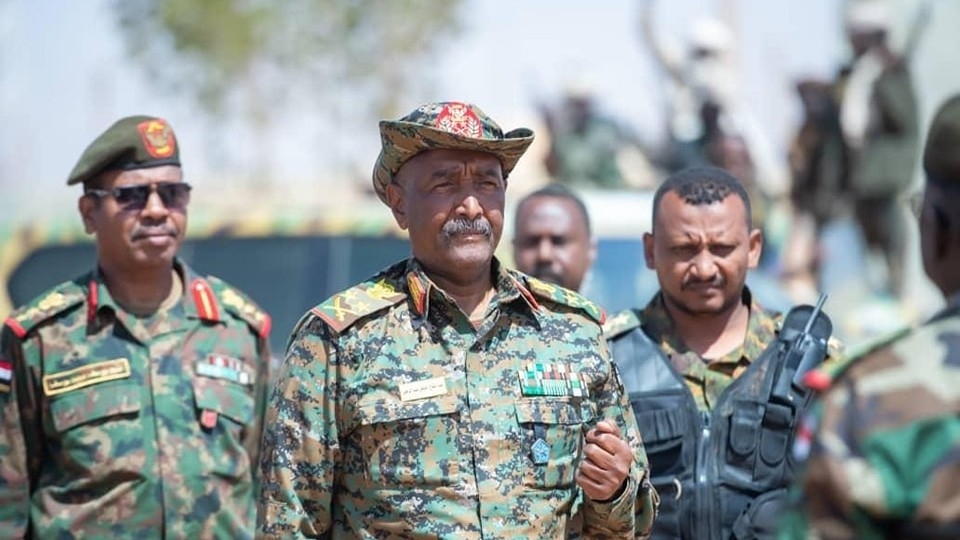
With a string of breakthroughs in Khartoum and elsewhere, the Sudanese military has seized the initiative and taken the fight to the paramilitary Rapid Support Forces (RSF) after months of setbacks.
Yet as its troops and supporters celebrate the advances, a gory video has emerged that appears to show army soldiers brandishing the decapitated heads of three alleged RSF fighters, drawing outrage and concern.
Sources in Khartoum and other parts of Sudan told Middle East Eye that the Sudanese Armed Forces (SAF) have retaken several strategic areas of the capital and its surroundings and are preparing an offensive on El-Gezira state to the south. RSF fighters have been struck by intensive bombing in locations across the country, they added.
Sudanese who have observed the fighting from the ground suggested to MEE that drones recently acquired from Iran have helped tilt the balance against the RSF, which controls most of the country.
The Mohajer-6 combat drones, which have sophisticated air-to-ground attack capabilities and have been seen in Iraq and Ukraine, have been used widely on the Sudanese battlefield, the sources said.
Stay informed with MEE's newsletters
Sign up to get the latest alerts, insights and analysis, starting with Turkey Unpacked
It remains to be seen whether the breakthrough signals a turning point in the war, which has killed thousands, displaced almost eight million people according to the UN, and brought parts of Sudan to the brink of famine.
Reversal of fortunes
Since late January, the Sudanese army has been concentrating its efforts in Omdurman and Bahri, cities that lie across the White Nile and Blue Nile rivers from Khartoum.
The previous months had seen a string of devastating defeats for the military. Out of all the strategic cities of Darfur, Sudan’s restive and sprawling western region, only El-Fasher remained in SAF hands by early November.
Meanwhile, RSF advances in central Sudan’s El-Gezira in December rocked the country, as well as the international aid community, which was using the state capital Wad Madani as a humanitarian hub.
'I see SAF soldiers controlling parts of Omdurman that they have never entered before, such as old Omdurman, Omdurman market... and 40th street'
- Abdullah al-Wathig, resident
Omdurman is beloved by Sudanese for its markets, which once hummed with activity. Yet since war broke out on 15 April over plans to fold the RSF into the regular military, Khartoum’s sister city has been in the eye of the storm.
Sudanese army soldiers have found themselves under siege in the Alia military hospital, the el-Mohandiseen garrison, Karary University and other locations. In Bahri, they’ve similarly been hunkered down in army bases, too. And in Khartoum, the military headquarters has been under siege for 10 months.
Omdurman residents told MEE that the army has control of most of the city’s streets for the first time since the war began. It has also seized parts of northern Bahri and relieved troops long besieged in the headquarters of the weapons unit.
According to the Sudan War Monitor, by relieving the el-Mohandiseen (engineering) garrison, the military has severed the RSF’s fighters in western Omdurman’s Ombada district to the old city on the bank of the White Nile.
Abdullah al-Wathig, an Omdurman resident, said there has been aggressive fighting since late January, with RSF fighters eventually fleeing from several positions.
“I see SAF soldiers controlling parts of Omdurman that they have never entered before, such as old Omdurman, Omdurman market, the popular market and 40th street, among other neighborhoods,” he told MEE.
“The fighting has been aggressive and there is bombardment everywhere. It’s a real nightmare for everybody, but we are happy that SAF has defeated them in the end.”
According to Wathig, hundreds of residents have celebrated in the streets with the advancing soldiers, including in the al-Abbasiya, al-Arda, al-Hashmab and al-Morada neighbourhoods.
Yet Shadia Omar, another Sudanese in Omdurman, said the RSF still controls parts of the city.
“To be honest, SAF has done well recently, defeating them in different places. But we can still see some RSF checkpoints,” she said.
From Bahri’s al-Halfaya neighbourhood, Amar Othman said fierce fighting has been going on around him.
“We have seen the SAF fighting in different parts of central, eastern and southern Bahri for the first time since the war,” he said.
“These are indescribable days. Now the fighting has been relaxed a little bit and we started to see some SAF checkpoints on the streets.”
'Our battle will continue'
In a recent report, the Armed Conflict Location and Event Data (Acled), a conflict mapping project, suggested the SAF breakthroughs may see troops reach the military headquarters in central Khartoum, which has been surrounded by the RSF from the very first day of the war.
Spurred by its humiliations in El Gezira and elsewhere, “SAF transitioned from a tactical defensive mode into an offensive one,” Acled said.
Contributing to this shift in balance, the group said, was the mobilisation of civilians against the RSF, with thousands taking up arms to fight the paramilitary militia in recent weeks.
Sudan War Monitor, meanwhile, suggested the army advances could be credited to the use of drones, including to find targets for artillery; deploying elite units; better supplies of ammunition; and less use of armoured vehicles, among other thing.
On Saturday, army chief Abdel Fattah al-Burhan visited Omdurman, appearing in locations such as the Alia military hospital that endured almost a year of besiegement. The army released footage of Burhan, who himself spent five months under siege in the military HQ in Khartoum, walking freely in Omdurman’s streets and addressing his troops.
“Our battle will continue,” he said, adding that negotiations with the RSF cannot begin while it continues the abuses it has been accused of, such as mass killings, looting and rape.
The United States, among others, has accused the RSF of war crimes and ethnic cleansing in Darfur. The Sudanese military has also been accused of war crimes. Both warring parties deny the accusations.
While the Sudanese army has buoyantly projected a sense of momentum, the Rapid Support Forces have been at pains to downplay the military’s advances, painting the news as disinformation.
'This is propaganda'
On Saturday, the paramilitary force published a video of its fighters in the key areas of Omdurman around the national radio and TV buildings. However the video was dated 12 February.
“SAF is lying in order to mobilise its soldiers, who have been besieged in different positions, lost their supplies and were starting to surrender to our forces,” a member of the RSF’s negotiation team told MEE, speaking anonymously as he was not authorised to speak to the media.
'This grievous act saw the brutal slaughter and beheading of three young men, executed in a manner reminiscent of the ISIS terrorist organisation'
- RSF statement
‘’This is propaganda that has been repeated, like their claim of controlling the airport road and the national radio and TV stations. All these positions are still in the hands of the RSF.”
The RSF has also seized upon a video that emerged last week, where men in army uniforms are seen brandishing the heads of three men they say were paramilitary fighters. Details about the video, including the location and when it was filmed, are scant.
“This grievous act saw the brutal slaughter and beheading of three young men, executed in a manner reminiscent of the ISIS terrorist organisation,” the RSF responded in a statement, accusing the army of responsibility.
The RSF linked the killings to elements from the repressive government led by former president Omar al-Bashir’s National Congress Party, which was ousted by Burhan and the RSF’s leader Mohamed Hamdan Dagalo, better known as Hemeti, following a popular uprising.
“We have consistently raised alarms regarding the National Congress Party and its terrorist arm, the Islamic Movement, as they extend their malevolent influence across the country,” it said on Monday.
A SAF spokesperson said the incident was being investigated.
Battles brewing elsewhere
Outside the capital, air strikes rain down on RSF positions. Raids have been carried out in El-Gezira state, as well as West Kordofan in the south and North Darfur, among other areas.
Sources in El-Gezira’s Hantoob said strikes have concentrated on the town and others nearby, particularly the bridge that crosses over to Wad Madani, where RSF checkpoints are deployed.
In Sennar, a city 100km south of Wad Madani, SAF soldiers told MEE that troops are on standby to move into El-Gezira and its state capital.
Far to the southwest, 800km from Khartoum, fierce fighting has erupted in the town of Babanusa in West Kordofan state.
According to Acled, the RSF launched an offensive on Babanusa on 22 January. After two weeks of clashes, the RSF appeared in control of much of the town, only to be forced back by army troops from many areas. At least 100 have been killed, sources there told MEE.
In North Kordofan’s al-Obeid, SAF soldiers told MEE they were poised to break the RSF’s siege on the city.
And further northwest, in the North Darfur capital of El-Fasher, SAF warplanes have been bombarding RSF forces surrounding the city, residents told MEE.
The sources in El-Fasher said the military was mobilising ground troops alongside ex-rebel groups, the Sudan Liberation Movement and the Justice and Equality Movement, preparing to take the fight to RSF fighters poised outside the city.
Middle East Eye delivers independent and unrivalled coverage and analysis of the Middle East, North Africa and beyond. To learn more about republishing this content and the associated fees, please fill out this form. More about MEE can be found here.
